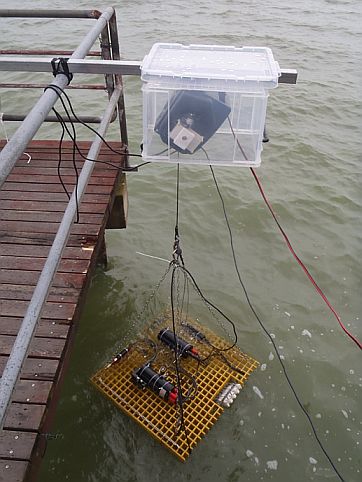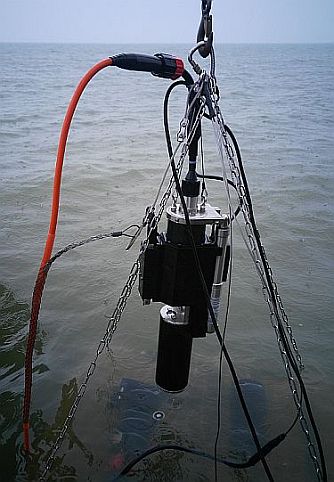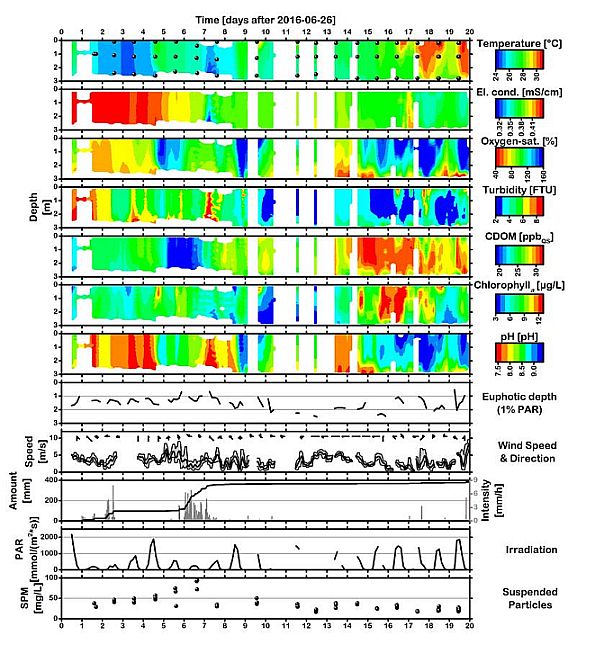WAQUAVID: Development of an Advanced Depth Profiling Monitoring System for Water Quality, Algae-Vitality, and -Diversity
- Contact:
- Project Group:
Environmental Mineralogy and Environmental System Analysis
- Funding:
WAQUAVID is funded by the Federal Ministry of Education and Research of Germany (BMBF grant no. 02WQ1375A) from 2016-2018.
- Partner:
KIT Institute of Photogrammetry and Remote Sensing (www.ipf.kit.edu)
ADM Elektronik (www.adm-elektronik.com)
bbe Moldaenke (www.bbe-moldaenke.de)
Project Description
Intact water bodies are amongst the most precious environmental resources for human life. But, worldwide, water bodies are threatened by severe anthropogenic inputs of various pollutants. Eutrophication develops due to excess supply of nutrients, particularly due to phosphorus and nitrogen input from agricultural, urban, and industrial sources. Subsequent extensive algal growth within water bodies can lead to highly problematic environmental conditions such as anoxia and release of the fermentation gasses H2S and CH4. Further, blooms of cyanobacteria (blue-green algae) can lead to formation and release of toxins being highly problematic for recreational and drinking water utilizations.
In this context, the KIT working group of Environmental Mineralogy and Environmental System Analysis (ENMINSA) is coordinating the WAQUAVID project funded by the BMBF within the KMU-innovativ program from 2016 till 2018. ENMINSA is working together with the KIT Institute of Photogrammetry and Remote Sensing (IPF), the company ADM Elektronik (ADM), and the company bbe Moldaenke (bbe) to develop and deploy a smart depth profiling in situ and online multi-sensor buoy system to monitor water quality conditions, as well as algae contents, diversity, and vitality. This system will be extended by the implementation of a meteorological measurement station as well as by hyperspectral cameras to analyze for spatially resolved distributions of different water constituents. Underwater, the following parameters are going to be recorded: (1) temperature, (2) electrical conductivity, (3) oxygen saturation, (4) pH-value, (5) turbidity, (6) chlorophylla, (7) phycocyanin, (8) colored dissolved organic matter, (9) photosynthetic active radiation, (10) CO2-content, (11) CH4-content, (12) flow direction, (13) flow velocity, (14) contents of 5 different algae classes, (15) biological activity of the respective algae, (16) potential release of cyanobacteria toxins. Above the water surface, (17) photosynthetic active radiation, (18) air temperature, (19) air humidity, (20) wind direction, (21) wind speed, and (22) precipitation will be monitored. The system will also include an advanced and remote controlled water sampling system for 16*50 mL samples. With hyperspectral cameras, wavelength dependent analysis of radiation reflected from the water surface enables to identify and quantify spatially resolved water constituents (e.g. turbidity, colored dissolved organic matter, algae). This already widely used practice is, however, highly dependent on the depth-resolved distribution of these water constituents across the water column. With the WAQUAVID system it will be possible for the first time to correlate hyperspectral images with respective corresponding depth profiles in the water body and, therefore, to fundamentally validate this methodology. It is intended to create a basis for reasonable transfer of this method to common remote sensing applications such as aerial and/or satellite images.
Data transmission and control of the profiling buoy system will be possible with bluetooth and mobile telephone system via web interface. As such, it will be possible from anywhere to follow recent water quality developments, to take targeted or automated samples, and by taking into account threshold values for the analyzed parameters to establish warning systems for critical water quality conditions. The energy needed to feed the buoy system will be autonomously supplied by a wind generator, solar panel, and rechargeable batteries.
The whole profiling buoy will become a modular system primarily designed for profiling depths of up to 30 m. Consequently, the sensor setup can be selected individually for numerous possible applications. Surveillance of e.g. drinking water resources, aquacultures, and environmentally protected water bodies, in freshwater, brackish water, and salt water are amongst the intended target areas. This new technology will, of course, also find manifold potential applications in recent questions of aquatic ecosystem research.



